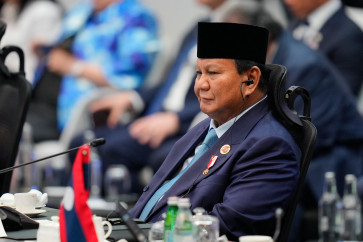Popular Reads
Top Results
Can't find what you're looking for?
View all search resultsPopular Reads
Top Results
Can't find what you're looking for?
View all search resultsLarger middle class does little for economy
Happiest moment: Bridegroom Yudi (center), a street singer, and his bride Susan (left) watch as children play fight to pick up coins from the floor during their wedding, which took place by the toilets of Juanda train station in Central Jakarta on Wednesday
Change text size
Gift Premium Articles
to Anyone
H
span class="caption" style="width: 398px;">Happiest moment: Bridegroom Yudi (center), a street singer, and his bride Susan (left) watch as children play fight to pick up coins from the floor during their wedding, which took place by the toilets of Juanda train station in Central Jakarta on Wednesday. According to the World Bank, the nation’s middle class grew by 61.73 percent to 131 million people in 2010, up from 81 million in 2003. Despite the trend, many people like Yudi and Susan cannot afford to live a reasonable life. JP/Wendra AjistyatamaIndonesia’s middle class has increased significantly over the past several years, but the impact of this increase on the country’s economy has been relatively small, according to analysts.
Mohammad Ikhsan, a senior economist at the University of Indonesia, said in Jakarta on Wednesday that although the middle class had grown considerably, the majority of its members spent only about US$2.00 a day on average.
“This group of people is still unable to make a significant contribution to the state. Most of them still enjoy the government’s subsidies,” he said, adding that their tax contribution was still small because their incomes were small.
According to a recently released World Bank Indonesia Economic Quarterly report, the middle class grew by 61.73 percent to 131 million in 2010 from 81 million in 2003, with more than 7 million people jumping from the low-income bracket to the middle class during the period.
The middle class in 2010 represented 56.6 percent of the country’s population, compared to 38 percent in 2003.
A middle-class person is defined as one who spends a minimum of $2.00 a day.
Despite the expanding demographic, the middle class is still dominated by lower-middle class people who spend $2.00 to $4.00 a day. This sub group represents 38.5 percent of the entire middle class.
In contrast, the upper-middle class, which spends $10 to $20 a day on average, makes up 1.3 percent of the middle class demographic.
The World Bank’s head economist for Indonesia Shubham Chaudhuri said the middle class’ expansion was partly a result of an increase in the number of people who had moved from the near-poverty line into the lower-middle class segment.
Although people with a per capita spending of about $2.00 a day still dominate the Indonesian middle class, the sharp increase in their number shows a significant improvement of the people’s welfare, he added.
Chaudhuri said it was now high time for the government to further increase the number of high added value jobs so that the middle-middle class bracket, whose per capital spending was $4.00 to $10 a day, would increase.
An increase of the population of this middle category would have a major impact on the nation’s economy, he added.
He said the country’s major challenge was to move lower-middle class people into the middle-middle group.
Ikhsan said he agreed that this movement between classes would have a greater positive effect on the country’s economy.
The government, he said, should also create a stable economy to stimulate the emergence of more entrepreneurs, because Indonesia’s middle class mostly consisted of professionals. (lnd)










